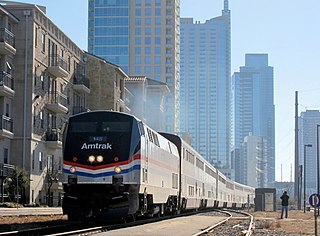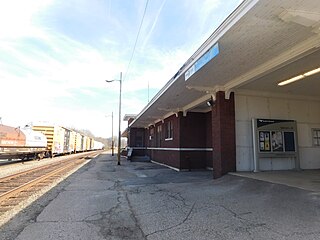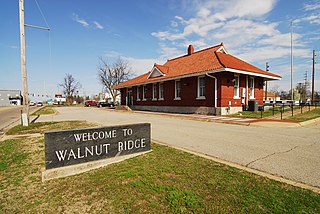
The Texas Eagle is a long-distance passenger train operated daily by Amtrak on a 1,306-mile (2,102 km) route between Chicago, Illinois, and San Antonio, Texas, with major stops in St. Louis, Little Rock, Dallas, Fort Worth, and Austin. Three days per week, the train joins the Sunset Limited in San Antonio and continues to Los Angeles via El Paso and Tucson. The combined 2,728-mile (4,390 km) route is the longest in the United States and the second-longest in the Americas, after the Canadian.

Dallas Union Station, officially Eddie Bernice Johnson Union Station, also known as Dallas Union Terminal, is a large intermodal railroad station in Dallas, Texas. It is the third busiest Amtrak station in Texas, behind Fort Worth Central Station and San Antonio station. It serves DART Light Rail Blue and Red lines, Trinity Railway Express commuter rail and Amtrak intercity rail. It is located on Houston Street, between Wood and Young Streets, in the Reunion district of Downtown Dallas. The structure is a Dallas Landmark and is listed on the National Register of Historic Places.

The Missouri Pacific Railroad, commonly abbreviated as MoPac, was one of the first railroads in the United States west of the Mississippi River. MoPac was a Class I railroad growing from dozens of predecessors and mergers. In 1967, the railroad operated 9,041 miles of road and 13,318 miles of track, not including DK&S, NO&LC, T&P, and its subsidiaries C&EI and Missouri-Illinois.

The St. Louis Southwestern Railway Company, known by its nickname of "The Cotton Belt Route" or simply "Cotton Belt", was a Class I railroad that operated between St. Louis, Missouri, and various points in the U.S. states of Arkansas, Tennessee, Louisiana, and Texas from 1891 to 1980, when the system added the Rock Island's Golden State Route and operations in Kansas, Oklahoma, and New Mexico. The Cotton Belt operated as a Southern Pacific subsidiary from 1932 until 1992, when its operation was assumed by Southern Pacific Transportation Company.

The Texas and Pacific Railway Company was created by federal charter in 1871 with the purpose of building a southern transcontinental railroad between Marshall, Texas, and San Diego, California.

The Alton Railroad was the final name of a railroad linking Chicago to Alton, Illinois; St. Louis, Missouri; and Kansas City, Missouri. Its predecessor, the Chicago and Alton Railroad, was purchased by the Baltimore and Ohio Railroad in 1931 and was controlled until 1942 when the Alton was released to the courts. On May 31, 1947, the Alton Railroad was merged into the Gulf, Mobile and Ohio Railroad. Jacob Bunn had been one of the founding reorganizers of the Chicago & Alton Railroad Company during the 1860s.

The Sunshine Special was inaugurated by the St. Louis, Iron Mountain and Southern Railway,, on December 5, 1915, to provide a premium level of passenger train service between St. Louis, Little Rock, and destinations in Texas, United States, such as El Paso, San Antonio, Laredo and Houston. An auxiliary section of the train originated in Memphis, Tennessee, and linked with the train in Little Rock, Arkansas.

St. Louis Union Station is a National Historic Landmark and former train station in St. Louis, Missouri, United States. At its 1894 opening, the station was the largest in the world that had tracks and passenger service areas all on one level. Traffic peaked at 100,000 people a day in the 1940s. The last Amtrak passenger train left the station in 1978.

Malvern station is a train station at 200 E. First Street in Malvern, Arkansas. A former Missouri Pacific Railroad station, this 24-by-84-foot red brick depot was originally constructed in 1916. Amtrak's Texas Eagle serves Malvern with one daily passenger train in each direction. The station is unstaffed and, because trains stop on a flag stop basis, advance reservations are strongly recommended.

Memphis Union Station was a passenger terminal in Memphis, Tennessee. It served as a hub between railroads of the Southwest, the Missouri Pacific Railroad and the St. Louis Southwestern Railway, and railroads of the Southeast, the Louisville and Nashville Railroad, the Nashville, Chattanooga and St. Louis Railway and the Southern Railway. The terminal, completed in 1912, was built in the Beaux-Arts style and was located on Calhoun Street, between south Second Street and Rayburn Boulevard. It was demolished in 1969. This location in south Memphis was approximately two blocks east of the other major Memphis railroad terminal, Memphis Grand Central Station.

Memphis Central Station, referred to as Grand Central Station prior to 1944, is a passenger terminal in Memphis, Tennessee. Located along Main Street and G.E. Patterson Boulevard in Downtown Memphis, it currently a service stop for Amtrak's City of New Orleans route, arriving in late evening northbound and in the morning southbound. It is also served by the MATA Trolley system. The building was opened in 1914, and is located within the city's South Main Arts District. It is also an contributing property to the South Main Street Historic District of the National Register of Historic Places, as are the National Civil Rights Museum and other historic properties within the district boundaries.
The Beaumont, Sour Lake and Western Railway was an 85-mile (137 km) railroad that ran from Beaumont, Texas to Gulf Coast Junction in Houston. It passed through small southeast Texas communities such as Hull, Kenefick, and Huffman. As part of the Gulf Coast Lines system, the road was eventually merged into the Missouri Pacific Railroad in 1956, which in turn was merged into the Union Pacific Railroad in 1982. The Union Pacific still makes heavy use of the route.

Walnut Ridge is a train station in Walnut Ridge, Arkansas, United States, that is currently served by Amtrak, the national railroad passenger system. It was originally a Missouri Pacific Railroad station and has been listed on the National Register of Historic Places since 1992.

Texarkana Union Station is a historic train station in the Texarkana metropolitan area serving Amtrak, the United States' national passenger rail system. The Arkansas-Texas border bisects the structure; the eastern part, including the waiting room and ticket office, are in Texarkana, Arkansas, but the western part is in Texarkana, Texas, meaning stopped trains span both states. The station was built in 1928 and was added to the U.S. National Register of Historic Places in 1978. Today it is the second busiest Amtrak station in Arkansas.

The Missouri River Runner is a 283-mile (455 km) passenger train service operated by Amtrak in Missouri between Gateway Transportation Center in St. Louis and Union Station in Kansas City. The eastern half of the route runs largely along the right bank of the Missouri River.

The Texas Eagle was an American streamlined passenger train operated by the Missouri Pacific Railroad and the Texas and Pacific Railway between St. Louis, Missouri, and multiple destinations in the state of Texas. It operated from 1948 to 1971. The Texas Eagle was one of many trains discontinued when Amtrak began operations in 1971, although Amtrak would revive service over the Missouri Pacific with the Inter-American in 1974. This train was renamed the Eagle in 1981 and finally the Texas Eagle in 1988.

The Yancopin Bridge is an abandoned railroad moveable bridge spanning the Arkansas River, and the last bridge across the Arkansas River before it flows into the Mississippi River 15 miles to the southeast. It is distinctive not only for its size and remoteness, but also for having not one but two movable spans, one having replaced the other due to river avulsion.

Hope station is a passenger rail station in Hope, Arkansas. The station is located on Amtrak's Texas Eagle line. Trains run daily between Chicago, Illinois, and San Antonio, Texas, and continue to Los Angeles, California, 2,728 miles (4,390 km) total, three days a week.

The Newport station, also known as Missouri-Pacific Depot-Newport, is a historic railroad station at Walnut and Front Streets in Newport, Arkansas. It is a long rectangular single-story brick and stucco topped by a hip roof, whose wide eaves are supported by large Italianate knee brackets. Its roof, originally slate, is now shingled, detracting from its original Mediterranean styling. A telegrapher's bay extends above the roof line on the track side of the building. The building was built in 1904 by the Missouri-Pacific Railroad to handle passenger and freight traffic.
E. M. Tucker was an American architect of St. Louis, Missouri, who worked for the Missouri Pacific Railroad.





















